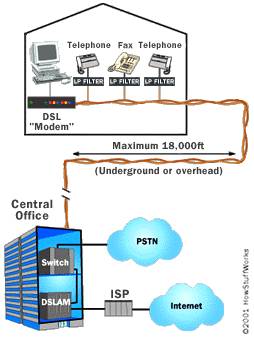Digital Subscriber Line (DSL) is a telecommunications technology for providing high-speed transmission to subscribers over the existing copper wire twisted-pair local loop between the customer premises and the telco’s central office (CO).

The Digital Subscriber Line (DSL) technology was designed to provide high-speed data and video-on-demand services to subscribers at speeds much faster than Integrated Services Digital Network (ISDN).
The essential advantage of using DSL is that it allows much faster data transmission rates over existing copper local loop telephone lines than traditional modems.
DSL standards are still evolving, and implementation is not yet widespread in most locations. In addition, DSL is competing with cable modem technologies to replace ISDN for high-speed Internet access.
How it works
DSL is not a specific digital line technology but rather a form of digital modem technology that defines the signaling processes for high-speed, end-to-end digital transmission over the existing copper twisted-pair wiring of the local loop. DSL accomplishes this by using advanced signal processing and digital modulation techniques. However, with DSL, the digital signals are not converted to analog or vice versa; instead, the signals remain digital for the complete communication path from the customer premises to the telco’s CO.
Usually, a DSL modem and a signal splitter are installed at the customer premises to separate voice and data signals. DSL modems can use a variety of modulation methods, including carrierless amplitude and phase modulation (CAP) or discrete multitone (DMT) technology modulation, depending on the vendor’s implementation. At the telco’s CO, a Digital Subscriber Line Access Multiplexer (DSLAM) connects subscribers to a high-speed Asynchronous Transfer Mode (ATM) backbone.
DSL actually represents a family of related services commonly referred to as “xDSL,” which includes the following:
- Asymmetric Digital Subscriber Line (ADSL), which allocates line bandwidth asymmetrically with downstream (CO to customer premises) data rates of up to 9 Mbps and upstream rates of up to 640 Kbps, depending on the implementation
- High-bit-rate Digital Subscriber Line (HDSL), which supports high-speed, full-duplex communication up to T1 or E2 speeds over multiple twisted-pair lines
- Symmetric Digital Subscriber Line (SDSL), which supports standard telephone communication and T1 or E1 data communication over a single twisted-pair line
- Very High-rate Digital Subscriber Line (VDSL), which supports downstream speeds of up to 52 Mbps over short distances
Depending on the type of xDSL technology used, signal modulation by the DSL modem might use CAP, DMT, or some other modulation process. (CAP is currently the most popular implementation.)